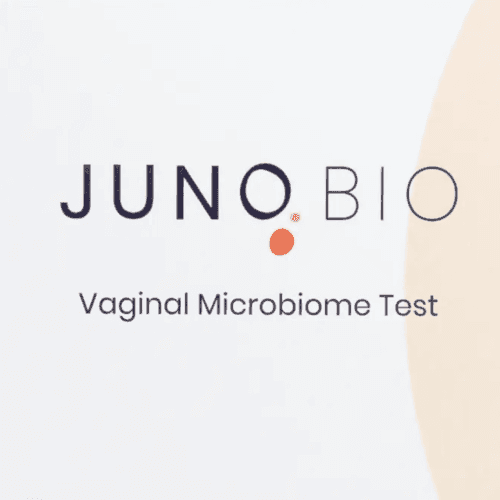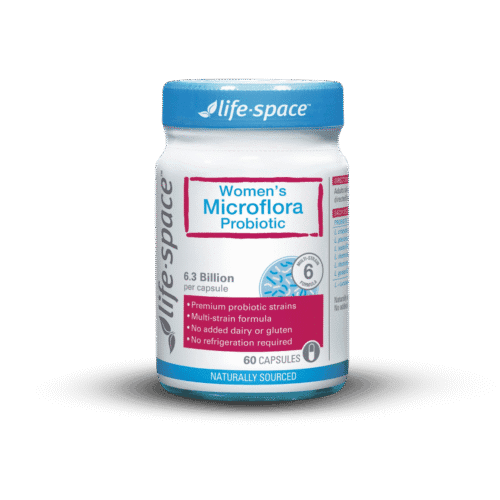Bacterial vaginosis (BV) is a very common vaginal condition affecting millions worldwide. BV can occur when there’s an imbalance in the vaginal microbiome, with a reduction in protective Lactobacillus species. This loss of lactobacilli then allows room for an increase in various types of disruptive bacteria, such as Gardnerella vaginalis or Prevotella species.
While BV is not a sexually transmitted infection (STI), it can be more common in people who are sexually active. The bacteria linked to BV can sometimes be shared between sexual partners, potentially leading to a cycle of re-infection.
Symptoms of BV often include a strong, fishy odour, particularly after sex. Other signs include a watery, thin grey or white vaginal discharge, as well as possible itching or irritation. Many of you seek bacterial vaginosis over-the-counter solutions to manage these uncomfortable and sometimes embarrassing symptoms.
What over-the-counter treatments work for bacterial vaginosis?
When considering bacterial vaginosis OTC treatment, it’s important to understand the capabilities of each treatment. Some over-the-counter products can help manage symptoms or support the vaginal microbiome, but they might not always resolve the underlying bacterial imbalance completely. Often, a more comprehensive approach is necessary, starting with a visit to the doctor for an accurate diagnosis.
Over-the-counter options typically fall into a few categories. These include vaginal pH-balancing gels, probiotics (both oral and vaginal), and some topical antiseptics. These products are widely available at pharmacies and supermarkets in many countries, making them accessible non-prescription BV treatment choices.
Vaginal pH-balancing gels and washes
The vaginal environment is naturally acidic. This is primarily due to the production of lactic acid by protective Lactobacillus bacteria. This acidity helps to inhibit the growth of disruptive bacteria. In BV, the vaginal pH is typically elevated, creating a more favourable environment for these unwanted microbes to thrive and cause the unpleasant symptoms.
pH-balancing gels or acidifying washes aim to restore the vaginal pH to its normal acidic range. This range is typically between 3.8 and 4.5. These products often contain ingredients like lactic acid or acetic acid (diluted vinegar). These treatments can provide temporary relief from symptoms like odour and discharge by altering the pH, making it less favourable for BV-related bacteria.
However, these acidifying gels and washes do not directly target the disruptive bacteria or repopulate with protective Lactobacillus species. Acidifying gels and washes are generally considered symptomatic treatments rather than curative ones for the underlying bacterial shift.
For some, using these products regularly can help maintain a balanced pH, potentially reducing the frequency of BV episodes. It’s useful to understand the difference here between a truly healthy vaginal microbiome and a BV microbiome that is being ‘managed’, but not modified, by these treatments.
It’s crucial to use products specifically designed for vaginal use. Regular soaps or douches can further disturb the delicate vaginal microbiome and worsen symptoms. Douches, in particular, are often advised against. They can wash away protective bacteria and change pH, possibly increasing the risk of BV and other vaginal infections.
But, you say, I already have BV! If you don’t have any protective lactobacilli bacteria to wash away, then it’s true, it doesn’t matter as much if you regularly douche. But it also means your lactobacilli or other protective species won’t be able to recover. Avoid douches and always get a comprehensive vaginal microbiome test and advice if you need it.
Probiotics for vaginal health
Probiotics contain live microorganisms. They are a popular over-the-counter BV medication choice, aiming to introduce or support beneficial bacteria in the body.
For vaginal health, specific strains of Lactobacillus are often used. These include Lactobacillus crispatus, L. jensenii, and L. gasseri. These strains are known for their ability to produce lactic acid, which helps maintain a low vaginal pH, and hydrogen peroxide, which can inhibit the growth of certain disruptive bacteria1. Probiotics reduce the recurrence rates of BV by half2.

Probiotics are available in oral capsules and vaginal pessaries or suppositories. Oral probiotics are designed to reach the vagina via the digestive tract. Vaginal probiotics are inserted directly into the vagina. Both routes aim to increase the population of protective Lactobacillus species.
Many people find that using probiotics, either alone or with other treatments, helps alleviate symptoms and reduce the recurrence of BV. Products like Life‑Space Women’s Microflora Probiotic are oral options. V‑Spot vaginal probiotic is a direct vaginal application.
The effectiveness of probiotics can vary depending on the specific strains used, the dosage, and the individual’s unique microbiome. It is our experience here at My Vagina that probiotics are most effective when combined with other strategies.
Topical antiseptics
Some over-the-counter topical antiseptics or antimicrobial washes, such as Betadine, claim to help with vaginal odour or discharge. These antiseptics typically contain ingredients with a broad-spectrum effect against various microbes.
While they might temporarily reduce the bacterial load and symptoms, they can also affect beneficial bacteria. This could potentially lead to further imbalance in the long term. It’s essential to exercise caution when using any antiseptic products.
Opt for those specifically formulated for vaginal use, avoiding harsh chemicals or non-specific antibacterials, such as Fluomizin.
Fluomizin (dequalinium chloride) is available in some regions as easy-to-use vaginal tablets. These can be beneficial for reducing the bacterial load and alleviating symptoms completely in some individuals. We love Fluomizin!
Can I treat BV without a prescription?
Yes, it’s possible to explore bacterial vaginosis self-treatment options as long as you have a diagnosis from a doctor. You can attempt to manage BV without a prescription. This is particularly true for mild cases or as a supportive measure in conjunction with professional guidance.
Many people successfully use over-the-counter BV remedies to alleviate symptoms. However, it’s important to understand the limitations and potential need for a more substantial intervention.
For recurrent or persistent BV, prescription medications such as oral or vaginal antibiotics are often prescribed. Antibiotics work to eradicate the disruptive bacteria. Common prescription treatments include metronidazole or clindamycin.
While effective, these antibiotics can sometimes have side effects, including digestive upset with oral forms or post-antibiotic vaginal yeast infections. They may also disrupt the beneficial Lactobacillus populations, potentially leading to recurrence.
This is where over-the-counter BV remedies and holistic approaches can play a significant role, providing symptom relief, supporting the recovery of a healthy vaginal microbiome, and addressing other factors, such as biofilms.
pH-balancing gels or washes can quickly alleviate odour and discharge. Probiotics help to re-establish protective Lactobacillus species. This is crucial for long-term vaginal health and preventing recurrence.
Holistic approaches consider dietary factors, lifestyle, and partner involvement in managing BV. For instance, the Killing BV Penis Treatment Guide addresses how male partners may be influencing recurrent BV in their female partners by carrying and transmitting BV bacteria and biofilms3.
When considering non-prescription BV treatment, it’s always advisable to use accurate vaginal pH strips to monitor your vaginal pH. An elevated pH (typically above 4.5) is a strong indicator of BV. This can help guide your treatment choices and allow you to see when treatments are working.
How effective are OTC BV treatments?
The effectiveness of over-the-counter (OTC) bacterial vaginosis treatment varies significantly. It depends on the product, the severity of the BV, and individual factors. For mild symptoms or as a preventative measure, over-the-counter BV medication can be quite effective.
However, for established or recurrent BV, these options often serve best as adjunctive therapies alongside more targeted treatments or as part of a comprehensive management plan.
Effectiveness of pH-balancing gels
pH-balancing gels can offer rapid, although temporary, relief from symptoms like fishy odour. They do this by acidifying the vaginal pH. Studies show that restoring the acidic environment can inhibit the growth of some disruptive bacteria4.
An acidic vagina can also allow protective Lactobacillus to thrive. However, these products typically do not address the root cause of the bacterial imbalance. Symptoms may return once use is discontinued.
Efficacy of probiotics
The efficacy of probiotics for BV is an area of ongoing research. Some studies suggest that specific strains of Lactobacillus, particularly those delivered vaginally, can be effective in both treating BV and preventing recurrence1,2.
For instance, the use of vaginal Lactobacillus strains has been shown to restore the vaginal microbiome and reduce the risk of BV recurrence. Oral probiotics, while generally safer and easier to use, may take longer to establish in the vaginal environment. Their efficacy can be more variable.
Aunt Vadge’s Lactulose Prebiotic & Probiotic Kit is designed to support systemic and vaginal probiotic balance.
Limitations of OTC options
OTC BV treatment might not be potent enough to significantly reduce the load of highly resistant disruptive bacteria in severe cases of BV. These treatments may also not address biofilm formation.
Biofilms serve as a protective shield for communities of bacteria that adhere to surfaces, making them more resistant to various treatments. Products like InterFase Plus or Aunt Vadge’s Biofilm Enzyme Blend are specifically designed to address these biofilms.
While some over-the-counter BV remedies can provide relief, they often do not prevent recurrence effectively on their own. This is particularly true if contributing factors, such as partner involvement or underlying immune health issues, are not addressed.
This is where a holistic approach, as offered through comprehensive programs like the Killing BV Vagina Treatment Guide, becomes crucial.
OTC bv treatment does not provide a diagnosis. Misdiagnosis is common, as symptoms of BV can overlap with other vaginal conditions like a yeast infection or even a sexually transmitted infection.
It’s essential to confirm a BV diagnosis. Ideally, this is done through a healthcare professional before deciding on a treatment strategy.
Overall, while there are promising BV over the counter remedies, for optimal results – especially in recurrent or persistent cases – integrating these treatments into a broader strategy that may include professional consultation and targeted natural therapeutics is often the most effective path.
The role of partner treatment in managing BV
An often-overlooked aspect of recurrent bacterial vaginosis is the potential involvement of sexual partners. While BV is not classified as an STI, research suggests that the disruptive bacteria associated with BV can be transmitted between sexual partners3.
This means that even if one partner successfully treats their BV, reinfection can occur if their sexual partner harbours the same disruptive microbes. We’ve known about this for over a decade, yet male partner treatment is still not the norm due to conflicting research into the efficacy of oral antibiotics in partners.
We now know from recent research3 that oral and topical treatments in men and people with peniswes work best to reduce BV recurrence rates.
BV and people with penises
For people with penises, it’s useful to know that BV-associated bacteria can reside in and on the penis. This is particularly true under the foreskin or within the urethra. It often occurs without causing any noticeable symptoms, with this asymptomatic carriage potentially leading to a cycle of re-infection for their partners. Addressing this aspect is crucial for breaking the cycle of recurrent BV.
This is why a comprehensive approach to bacterial vaginosis self-treatment often includes strategies for partners. For instance, the My Vagina clinic offers specific guidance and treatment options for partners. These include the Killing BV guides and extend to specific products, such as the Four-Pronged Approach Box – Penis.
This kit includes topical and oral herbal medicines designed to reduce the bacterial load and introduce lactobacillus colonies in individuals with penises. Incorporating partner treatment can significantly improve the long-term success of managing BV and reduce the frustrating pattern of recurrence. Check the guide for more information.
Nutritional and lifestyle support for bacterial vaginosis
Beyond specific over-the-counter BV medication, integrating nutritional and lifestyle adjustments can significantly support vaginal health and aid in the management of bacterial vaginosis. These approaches work by bolstering the body’s natural defences and creating an environment less hospitable to disruptive bacteria.
Dietary considerations
A balanced diet, rich in whole foods, prebiotics, and probiotics, can foster a healthy gut microbiome. This, in turn, influences the vaginal microbiome through various mechanisms, ranging from reduced inflammation to increased nutrient absorption.
Prebiotic foods
Prebiotics are non-digestible fibres that feed beneficial bacteria. Examples include garlic, onions, leeks, asparagus, bananas, and whole grains. Incorporating these fibres into your diet can support the growth of protective Lactobacillus species.
Lactulose, a prebiotic, is available as Aunt Vadge’s Lactulose Vaginal Prebiotic, a great option to feed beneficial bacteria directly in the vagina.
Fermented foods
Foods like unsweetened yoghurt, kefir, sauerkraut, and kimchi contain beneficial bacteria. These can contribute to overall microbial balance. Opt for products with live and active cultures.
Limit sugar and refined carbohydrates
Excessive sugar intake can promote the growth of yeast and other disruptive microorganisms, and contribute to inflammation. This could potentially exacerbate vaginal microbial imbalances.
Immune system support
A robust immune system is essential for maintaining a healthy microbiome and fending off infections.
Key nutrients
Ensure adequate intake of vitamins and minerals. Vitamin C, vitamin D, and zinc are especially crucial for immune function.
Lactoferrin
This protein, found in milk, has antimicrobial and immune-modulating properties. Supplementation with bovine lactoferrin, such as Aunt Vadge’s Bovine Lactoferrin, can be beneficial, especially if BV is accompanied by low immunity or iron levels.
Sleep and stress management
Chronic stress and lack of sleep can suppress the immune system. This makes individuals more susceptible to infections. Prioritising restful sleep and incorporating stress-reducing practices like meditation or yoga can support overall health.
Vaginal hygiene practices
Gentle and appropriate vaginal hygiene is vital to avoid disrupting the delicate balance of the vaginal microbiome.
- Avoid harsh soaps and douches. These can strip away protective bacteria and elevate vaginal pH, increasing the risk of BV.
- Use plain water or a mild, pH-balanced intimate wash.
- Wear breathable underwear. Cotton underwear can help maintain a dry environment, discouraging the growth of disruptive bacteria.
- Practise proper wiping. Always wipe from front to back after using the toilet to prevent the transfer of faecal bacteria to the vagina.
By integrating these nutritional and lifestyle strategies, individuals can create a more resilient vaginal environment. This makes them less prone to BV and supports the effectiveness of other bacterial vaginosis OTC treatment options.
When to seek professional help
While bacterial vaginosis self-treatment is a viable option for many, it’s crucial to recognise when professional medical advice is necessary. Certain situations warrant a consultation with a healthcare practitioner, even when exploring over-the-counter BV remedies.
You should consider seeing a doctor or a specialist naturopath if:
- Your symptoms persist or worsen
- You experience recurrent BV
- You are pregnant or breastfeeding
- You have new or unusual symptoms
- You suspect another infection
If your over-the-counter BV remedies do not lead to improvement within a few days, or if your symptoms become more severe, it’s time to seek professional guidance. If you frequently experience BV, even after trying various treatments, a healthcare professional can help identify underlying causes, such as partner involvement or biofilm presence. They can then recommend a more targeted treatment plan.
For instance, if Prevotella bacteria are identified as a contributing factor, specific support like Aunt Vadge’s BV‑Prevella Clear might be considered as part of a comprehensive strategy.
BV during pregnancy can increase the risk of complications such as preterm birth. It’s essential to consult a doctor for an appropriate diagnosis and treatment if you are pregnant and suspect you have BV. If you develop a fever, pelvic pain, or discharge that differs from typical BV symptoms, this could indicate a more serious infection that requires immediate medical attention.
Symptoms of BV can sometimes be confused with other vaginal conditions like a yeast infection or even a sexually transmitted infection. An accurate diagnosis is crucial for effective treatment. If you suspect you have an STI, it’s essential to get tested. Professional medical advice is paramount for the diagnosis and treatment of STIs.
A healthcare professional can provide an accurate test and diagnosis. They can also rule out other conditions and prescribe medication if necessary. A doctor can also offer guidance on long-term management strategies, including the use of targeted holistic treatments, to help prevent recurrence.
What to do next
Navigating bacterial vaginosis and finding effective bacterial vaginosis over-the-counter options can feel overwhelming. However, remember that you have many tools and resources available. Whether it’s your first time with symptoms or you’re managing recurrent BV, understanding your options is the first step towards feeling better.
For a comprehensive approach to managing bacterial vaginosis and exploring bacterial vaginosis self-treatment, we recommend considering the following:
Understand your vaginal microbiome
Knowing the specific bacteria present can significantly inform your treatment choices. A comprehensive vaginal microbiome test, such as the Juno comprehensive vaginal microbiome test, can provide invaluable data.
This incredibly detailed (but easy to read!) test helps identify not only the disruptive bacteria causing your BV but also the protective Lactobacillus species present, guiding you towards the most effective strategies. Juno tests also include yeast and fungus.
Explore holistic treatment programs
Our Killing BV Vagina Treatment Guide offers an online learning format. It provides a structured approach to understanding and managing BV effectively. This program delves into dietary support, lifestyle adjustments, and targeted natural therapeutics.
For a partner with a penis, especially if you experience recurrent BV, the Killing BV Penis Treatment Guide is an important tool.
Consider over-the-counter remedies from our clinic
- Aunt Vadge’s BV Rescue and Aunt Vadge’s Double Whammy are designed to help restore balance.
- Life‑Space Women’s Microflora Probiotic or V‑Spot vaginal probiotic can support the re-establishment of protective Lactobacillus species.
- For more complex cases, such as those involving Prevotella, Aunt Vadge’s BV‑Prevella Clear might be beneficial.
- If you suspect biofilms are contributing to your persistent BV, consider InterFase Plus or Aunt Vadge’s Biofilm Enzyme Blend.
Monitor your vaginal pH
Use accurate vaginal pH strips to monitor your vaginal pH. This can give you immediate feedback on your vaginal environment and provide clues as to when your treatments are working.
If you are unsure about the best path forward or if your symptoms persist, we strongly recommend booking an appointment with one of our specialist naturopaths.
Our team can provide personalised guidance and develop a tailored treatment plan based on your unique situation. Alternatively, you can complete our free support assessment for initial guidance – find details on how to submit the form inside Killing BV.
We are committed to helping you achieve lasting vaginal health!
References
- 1.Santarelli G, Rosato R, Cicchinelli M, et al. The activity of cell-free supernatant of Lactobacillus crispatus M247: a promising treatment against vaginal infections. Front Cell Infect Microbiol. Published online June 11, 2025. doi:10.3389/fcimb.2025.1586442
- 2.Chieng WK, Abdul Jalal MI, Bedi JS, et al. Probiotics, a promising therapy to reduce the recurrence of bacterial vaginosis in women? a systematic review and meta-analysis of randomized controlled trials. Front Nutr. Published online September 20, 2022. doi:10.3389/fnut.2022.938838
- 3.Vodstrcil LA, Plummer EL, Fairley CK, et al. Male-Partner Treatment to Prevent Recurrence of Bacterial Vaginosis. N Engl J Med. Published online March 6, 2025:947-957. doi:10.1056/nejmoa2405404
- 4.Bradshaw CS, Brotman RM. Making inroads into improving treatment of bacterial vaginosis – striving for long-term cure. BMC Infect Dis. Published online July 29, 2015. doi:10.1186/s12879-015-1027-4







